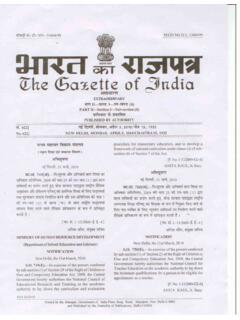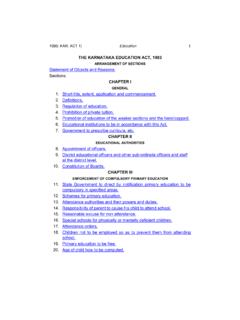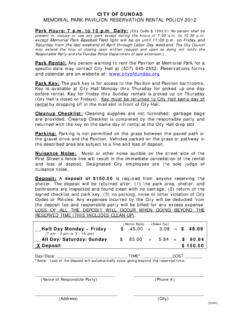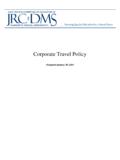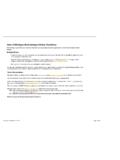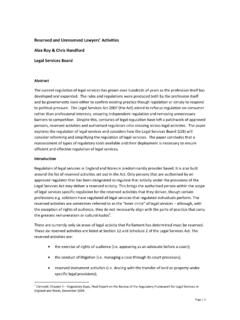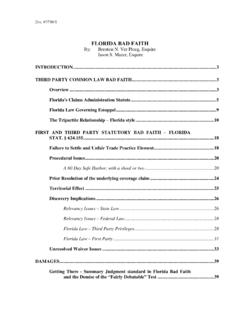Transcription of Shailey Tucker and Gayatri Sahgal* - Right To …
1 AI policy Briefs, June 2012 25% reservation under the RTE: Unpacking the Rules in PAISA States 1 25% reservation under the RTE: Unpacking the Rules in PAISA States Shailey Tucker and Gayatri Sahgal* * AI policy Briefs, June 2012 25% reservation under the RTE: Unpacking the Rules in PAISA States 2 25% reservation under the RTE: Unpacking the Rules in PAISA States 1. Introduction In its landmark judgment on April 12, 2012, the Supreme Court upheld the Constitutional validity of the Right to Free and Compulsory Education (RTE) Act, 2009, which mandates a minimum of 25% free seats for children belonging to weaker sections and disadvantaged groups (EWS) in all private unaided primary schools. In particular, Section 12 (1)(c) of the RTE Act stipulates that the 25% reservation be implemented while admitting students to Class Given the salience of such provisions, deeper scrutiny is required on their nuances and the manner in which they are to be implemented: How will eligible children be selected?
2 How will private schools be reimbursed for their expenditure? What additional provisions exist under the Act for children falling in these categories? With a view to better understand the process of implementation of Section 12 of the Act, this brief describes the relevant provisions of the Act and Rules of the PAISA states, namely: Andhra Pradesh (AP), Bihar, Himachal Pradesh (HP), Madhya Pradesh (MP), Maharashtra and Rajasthan. In doing so, it provides an overview of the differences across states, highlighting the strengths and weaknesses of the state-wise provisions regarding implementation of the 25% reservation . 2. Maintenance of Records of Children The RTE Act mandates that [e]very child of the age of six to fourteen years shall have a Right to free and compulsory education in a neighbourhood school till completion of elementary education.
3 2 In accordance with Section 12(1) of the Act, it is from within this neighbourhood that each school is to admit children belonging to EWS. According to Section 12 (1)(c) of the Act, all specified category or private schools must reserve 25% of their seats for children belonging to EWS from the neighbourhood and provide them 1 Specifically, free and compulsory education must be provided to children between the ages of 6 and 14 years of age; private unaided religious/minority schools are exempt. 2 RTE Act, Section 3. AI policy Briefs, June 2012 25% reservation under the RTE: Unpacking the Rules in PAISA States 3 admission from Class I onwards; wherever such a school provides pre-school education, these rules are to be applied to the pre-school section as well.
4 The State Government and/or Local Authority3 is responsible for deciding the area or limits of the neighbourhood for each school (RTE Act, Section 6) and, according to the RTE Rules (2010), a primary school is to be located within 1km of each neighbourhood and an upper-primary school within While most states have specified these limits, there are some inter-state variations. For instance, in HP a primary school must be located within of a neighbourhood and must have a minimum of 25 enrolled children between the ages of 6-11 years. In, MP however, no distance for primary schools is specified (only that it should be located in the village/ward, adjoining villages/wards of a given rural/urban area). In both Bihar and MP, there is a provision for the extension of the neighbourhood as identified by the State Government and/or Local Authority in case all the reserved seats are not filled,5 yet they do not specify any other details of the extension.
5 3. Definitions of Disadvantaged Groups and Weaker Section Before discussing the provisions in each state, it is useful to know how the terms disadvantaged groups and weaker section have been defined. Section 2, Clauses (d) and (e) of the RTE Act define these terms as follows: Table 1: Definitions of Disadvantaged Groups and Weaker Sections Disadvantaged Groups Weaker Section A child belonging to disadvantaged groups refers to a child belonging to the Scheduled Caste, the Scheduled Tribe, the socially and educationally backward class or such other group having disadvantage owing to social, cultural, economical, geographical, linguistic, gender or such other fact, as may be specified by the appropriate Government, by notification (RTE Act, 2009, Section 2, Clause (d)).
6 A child belonging to weaker section refers to a child belonging to such parent or guardian whose annual income is lower than the minimum limit specified by the appropriate Government, by notification (RTE Act, 2009, Section 2, Clause (e)). 3 Local Authority refers to a Municipal Corporation, Municipal Council, Zila Parishad, Nagar Panchayat, Panchayat, or any other body which has (or is empowered to have) administrative control over the school (RTE Act, Section 2, Clause (h)). 4 Right of Children to Free and Compulsory Education Rules, 2010 (RTE Rules), Rule 6. 5 Bihar Rules, Rule 7, Sub-rule 3; MP Rules, Rule 7, Sub-rule 3. AI policy Briefs, June 2012 25% reservation under the RTE: Unpacking the Rules in PAISA States 4 The Rules in Bihar and Maharashtra do not expand on the definitions given above.
7 The Himachal Pradesh Rules, 2011, however, specify that those children who belong to a Below Poverty Line (BPL) SC/ST/OBC family or who are disabled would be considered MP and Rajasthan have similar definitions, which include: SC/ST children; the physically handicapped (up to 40% disabled in Rajasthan; more than 40% disabled in Madhya Pradesh); children belonging to families eligible under the Scheduled Tribes and Other Traditional Forest Dwellers (Recognition of Forest Rights) Act, 2006; and girls (in Rajasthan).7 All children belonging to BPL families in HP, MP and Rajasthan are included under the weaker section category. In comparison, the Andhra Pradesh Rules, 2010, are the most articulate, outlining the proportion of seats to be reserved for groups defined as disadvantaged and weak.
8 The reservation for disadvantaged categories is defined as 19%, while that for weaker sections stands at 6%.8 The following table shows a break-up of the reservation policies in the state according to sub-categories: Table 2: reservation Policies under RTE in Andhra Pradesh Disadvantaged Groups 19% Weaker Section 6% Orphans, HIV-affected, disabled, special need, migrant & street children: 5% SC: 10% ST: 4% OBC + Minorities + Other Castes (with per annum income less than Rs. 60,000) The AP Rules also stipulate separate practices and prioritise certain sub-categories while implementing reservation policies for private schools located in different areas. For instance, for reservation in schools located in plain areas, preference must first be given to orphans, HIV-affected children and disabled children.
9 Thus only after these seats are exhausted, will seats for SC and ST categories be filled. Similarly, children belonging to weaker sections can then only be admitted once the seats for SC and ST categories have been filled. Correspondingly, in schools located in tribal areas, all ST children should be 6 The Right of Children to Free and Compulsory Education, Himachal Pradesh Rules, 2011(HP Rules). 7 Rajsathan Right of Children to Free and Compulsory Education, 2010 (Rajasthan Rules) and Right of Children to Free and Compulsory Education Rules, 2011 (MP Rules). 8 The Andhra Pradesh Right of Children to Free and Compulsory Education, 2010 (AP Rules) AI policy Briefs, June 2012 25% reservation under the RTE: Unpacking the Rules in PAISA States 5 enrolled first, followed then by SC children; the remaining seats (if any) would be filled by other categories.
10 4. Maintenance of Records of Children In order to facilitate the above process, the Local Authority is to maintain records of all children in its jurisdiction, by means of a household survey, and these are to be updated each Each child s record must be kept from birth till 14 years of age and, among other things, must state whether the child belongs to the weaker section or disadvantaged group as specified under the However, not all State Rules in our sample states specify which authority is to maintain an updated list of children belonging to these two categories and which schools they attend (whether unaided, aided or specified category school). While in MP the responsibility lies with the Jan Shikshak or Cluster Resource Centre Coordinator (CRCC), in Rajasthan it lies with the Block Elementary Education Officer (BEEO).

